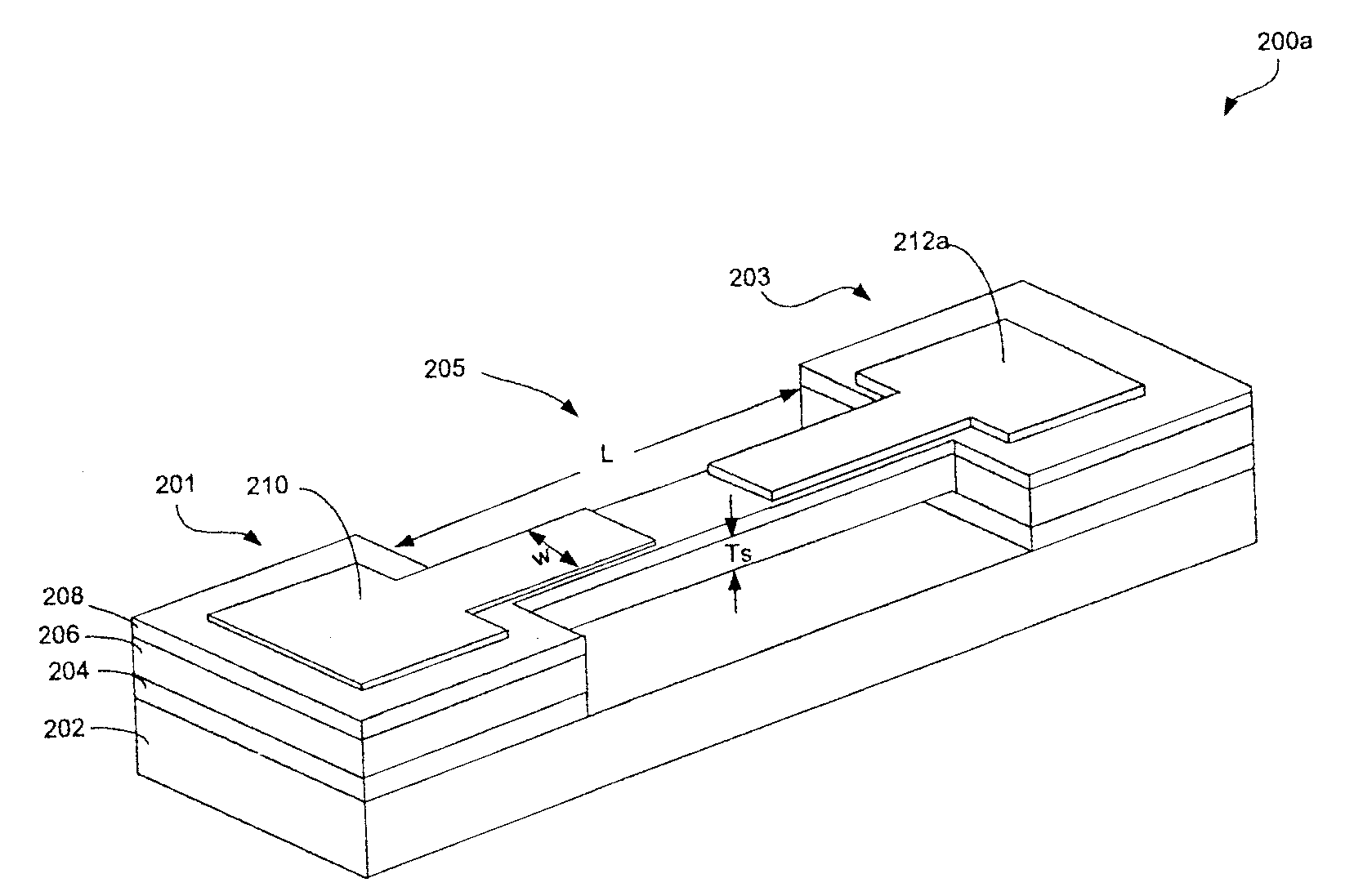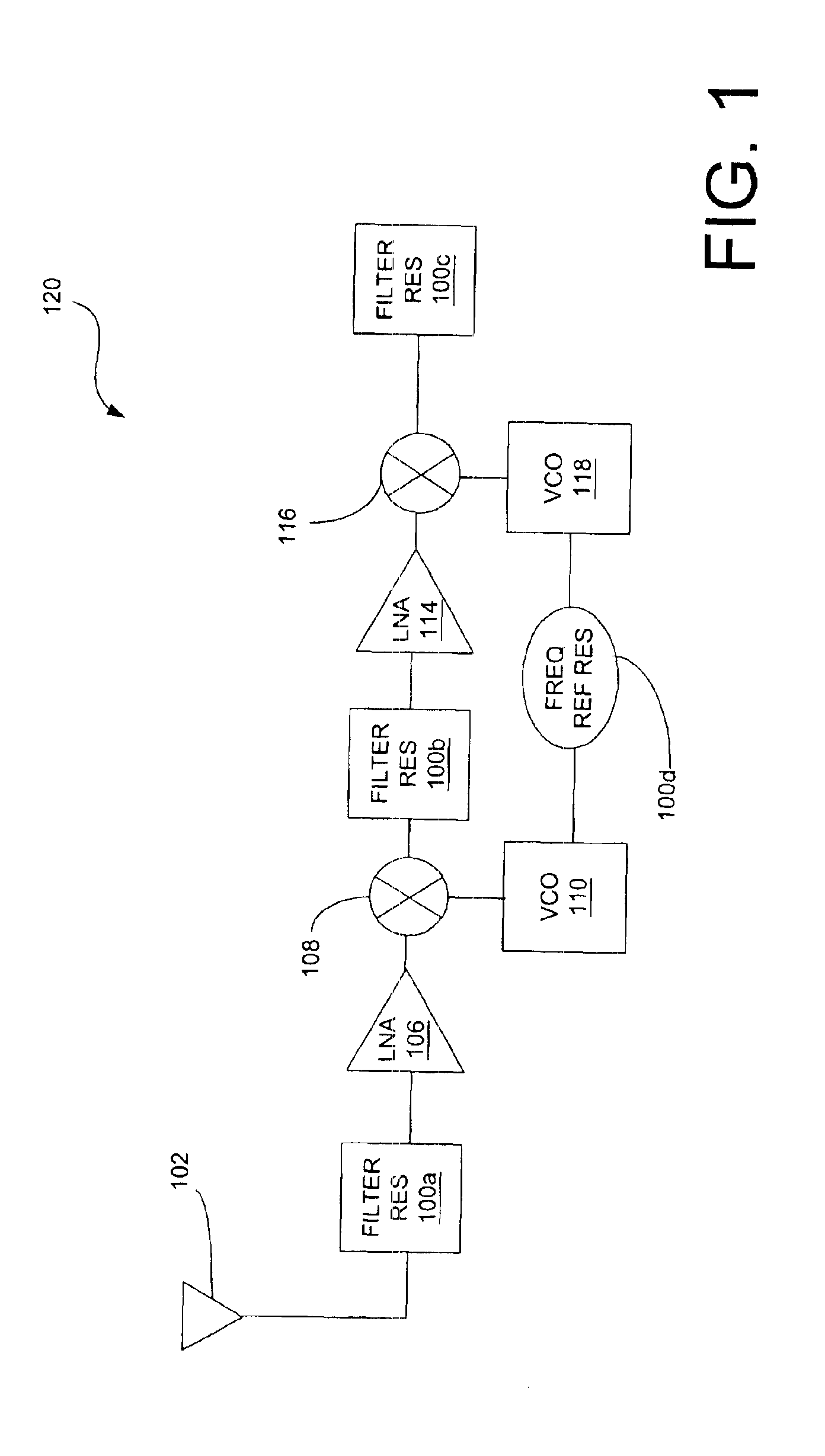Piezoelectric on semiconductor-on-insulator microelectromechanical resonators
a microelectromechanical and semiconductor technology, applied in piezoelectric/electrostrictive devices, piezoelectric/electrostrictive/magnetostrictive devices, piezoelectric/electrostrictive/magnetostriction machines, etc., can solve the problems of low quality factor of fbar resonators, no electrostatic fine tuning capability, and limited size and cost of frequency selective units in miniature radios and wristwatches
- Summary
- Abstract
- Description
- Claims
- Application Information
AI Technical Summary
Problems solved by technology
Method used
Image
Examples
first embodiment
[0025]FIGS. 2A-2C are schematic diagrams that illustrate several piezoelectric beam resonator embodiments. FIG. 2A is a schematic diagram of a first embodiment configured as a clamped-clamped resonator beam 200a. The clamped-clamped resonator beam 200a includes a handle layer 202, an oxide layer 204, a device layer 206, a piezoelectric layer 208, a drive electrode 210, and a sense electrode 212 a The “clamped” regions 201 and 203 correspond to the location where the SOI substrate is secured to the underlying handle layer 202, which in turn can be secured to a printed circuit board, among other devices. In some embodiments, the underlying handle layer 202 is the substrate in an integrated circuit, to which the SOI portion is secured. The “beam” region 205, having a length “L,” spans between the two clamped regions 201 and 203, and includes the portion of the piezoelectric resonator 200a that is free to vibrate. The device layer 206 and the oxide layer 204 collectively represent the S...
second embodiment
[0028]FIG. 2B is a schematic diagram of a second embodiment configured as a clamped-clamped resonator beam 200b with the piezoelectric layer 208 etched away. Layers similar to 202-206 and electrodes 210 and 212a of FIG. 2A are the same as shown in FIG. 2B and thus are not discussed here for clarity. The piezoelectric layer 208 is etched in approximately the middle span of the beam 205 to reduce the effective covering of the beam 205 by the piezoelectric layer 208, thus exposing a surface of the device layer 206. Reducing the effective covering of the beam 205 by the piezoelectric layer 208 can enhance the mechanical Q of the piezoelectric beam resonator 200b (e.g., experimentally proven to at least double the mechanical Q when compared to the embodiment illustrated in FIG. 2A).
third embodiment
[0029]FIG. 2C is a schematic diagram of a third embodiment configured as a clamped-clamped resonator beam 200c with a sensing electrode 212b that extends further along the beam 205 than the sensing electrode 212a of FIGS. 2A-2B. The extending of the sensing electrode 212b covers the area where the strains have the same sign, thus maximizing the sensed strains and providing for improved sensing capability. The sensing electrode 212b extends over the middle span of the beam 205, with the edges located at the inflection points of the beam mode shape. The sensing electrode 212b may cover approximately twice the area covered by the sensing electrode 212a.
[0030]FIG. 3 is a schematic diagram that illustrates another embodiment in the form of a piezoelectric block resonator 300. The piezoelectric block resonator 300 includes a handle layer 302, an oxide layer 304, a device layer 306, a piezoelectric layer 308, a drive electrode 310, and a sense electrode 312. As shown, the piezoelectric bl...
PUM
 Login to View More
Login to View More Abstract
Description
Claims
Application Information
 Login to View More
Login to View More - R&D
- Intellectual Property
- Life Sciences
- Materials
- Tech Scout
- Unparalleled Data Quality
- Higher Quality Content
- 60% Fewer Hallucinations
Browse by: Latest US Patents, China's latest patents, Technical Efficacy Thesaurus, Application Domain, Technology Topic, Popular Technical Reports.
© 2025 PatSnap. All rights reserved.Legal|Privacy policy|Modern Slavery Act Transparency Statement|Sitemap|About US| Contact US: help@patsnap.com



